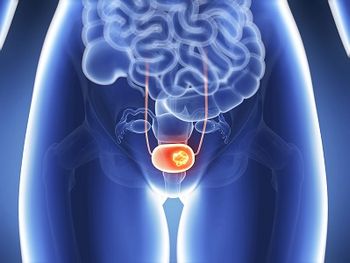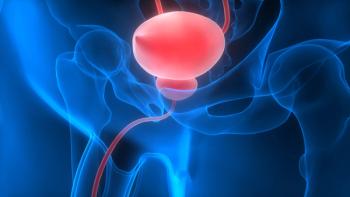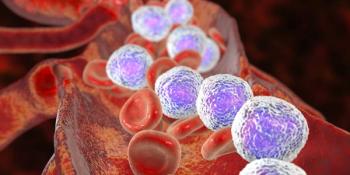
Perioperative Durvalumab/NAT Chemo Does Not Improve HRQOL in MIBC
New findings reveal that adding durvalumab to neoadjuvant chemotherapy does not enhance HRQOL in muscle-invasive bladder cancer patients.
Health-related quality of life data from the phase 3 NIAGARA trial (NCT03732677) showed perioperative durvalumab (Imfinzi) plus neoadjuvant chemotherapy was not improved for patients with muscle-invasive bladder cancer (MIBC), according to a presentation from the
Michiel van der Heijden, MD, PhD, a medical oncologist at the Netherlands Cancer Institute in Amsterdam, presented the findings at the conference in Berlin, Germany.
At last year’s ESMO Congress in Barcelona, Spain, Thomas B. Powles, MBBS, MRCP, MD, presented findings from NIAGARA. The patient population consisted of adults with cisplatin-eligible MIBC (cT2-T4aN0/1M0), urothelial cancer or urothelial cancer with divergent differentiation or histologic subtypes, evaluated and confirmed for radical cystectomy, and with creatine clearance of 40 mL/min or lower. Patient were randomly assigned 1:1 to either the durvalumab arm or the comparator arm. Patients in the durvalumab arm received neoadjuvant durvalumab, 1500 mg intravenously every 3 weeks and gemcitabine plus cisplatin for 4 cycles followed by radical cystectomy and 8 cycles of adjuvant durvalumab. Patients in the comparator arm received 4 cycles of gemcitabine plus cisplatin for 4 cycles followed by radical cystectomy. The 2 primary end points were event-free survival (EFS) and pathological complete response. Regarding EFS, there was a significant reduction in risk (HR=0.68, 95% CI, 0.56-0.82). Median follow-up was 42.3 months (range 0.03-61.3 months).2,3
Data from NIAGARA supported the FDA’s approval of neoadjuvant durvalumab in combination with gemcitabine and cisplatin, followed by adjuvant durvalumab monotherapy following radical cystectomy, for adult patients with muscle invasive bladder cancer.4
At ESMO 2025, van der Heijden presented HRQOL outcomes from the NIAGARA study. In NIAGARA, the European Organisation for Research and Treatment of Cancer (EORTC) QLQ-C30 and EQ-5D-5L were assessed via electronic device at baseline and every 4 weeks until disease progression. van der Heijden explained that the EORTC QLQ-C30 measures global health scale (GHS)/QoL as well as functional and symptom subscales. GHS/QoL and Physical, Fatigue, and Pain were included in NIAGARA as prespecified priority subscales, with a 10-point change in score compared with baseline being deemed clinically meaningful.
The EQ-5D-5L visual analogue scale is constructed for patients to rate their current overall health; for NIAGARA, the investigators reported visual analogue scale change from baseline.
A total of 439 (82.4%) of patients in the durvalumab arm completed the baseline EORTC QLQ-C30 assessment vs 450 (84.9%) patients in the comparator arm. In addition, 416 (78.0%) patients in the durvalumab arm completed the baseline and at least 1 postbaseline assessment vs 410 (77.4%) of patients in the comparator arm. The compliance rate range from baseline to adjuvant week 29 was 50.9%-82.4% in the durvalumab arm vs 44.3%-84.9% in the comparator arm.
For the EQ-5D-5L, 417 (78.2%) patients completed the baseline assessment vs 430 (81.1%) patients in the comparator arm. Further, 391 (73.4%) patients in the durvalumab arm completed the baseline and at least 1 postbaseline assessment vs 380 (71.7%) patients in the comparator arm. The compliance rate range from baseline to adjuvant week 29 was 49.9%-78.2% in the durvalumab arm vs 43.2%-81.1% in the comparator arm.
For GHS/QoL, van der Heijden reported that that the difference between arms for overall mean change from baseline (CFB) was 1.6 (95% CI, –0.44 to 3.69), and with the Physical Functioning subscale, the difference between arms for overall CFB was 1.2 (95% CI, –0.80 to 3.17). For the Fatigue subscale, the difference between arms for overall CFB was –0.9 (95% CI, –3.25 to 1.52), and for the Pain subscale, the difference between arms for overall CFB was –2.1 (95% CI, –4.44 to 0.16).
The EQ-5D-5L visual analogue scale “also did not show any difference between the treatment arms,” according to van der Heijden.
“Overall, the addition of perioperative durvalumab to neoadjuvant chemotherapy significantly improved event-free survival and overall survival without adversely affecting patient-reported outcomes,” van der Heijden said in his concluding remarks.
DISCLOSURES: van der Heijden noted research funding (paid to institute) from Bristol Myers Squibb, Merck/MSD, AstraZeneca, Roche, and 4SC, as well as consulting fees (paid to institute) from Bristol Myers Squibb, Merck/MSD, AstraZeneca, Astellas, Pfizer, Seagen, Janssen, and Daiichi Sankyo.
References
- 1. van der Heijden M, Powles TB, Galsky MD, et al. Health-related quality of life (HRQOL) outcomes from the NIAGARA trial of perioperative durvalumab (D) plus neoadjuvant chemotherapy (NAC) in muscle-invasive bladder cancer (MIBC). Presented at: European Society for Medical Oncology Congress. October 17-21, 2025. Berlin, Germany. Abstract 3069MO.
- 2. Powles TB, van der Heijden MS, Galsky MD, et al. A randomized phase III trial of neoadjuvant durvalumab plus chemotherapy followed by radical cystectomy and adjuvant durvalumab in muscle-invasive bladder cancer (NIAGARA). Presented at: 2024 European Society for Medical Oncology Annual Congress. September 13-17, 2024. Barcelona, Spain. Abstract LBA5. https://cslide.ctimeetingtech.com/esmo2024/attendee/confcal/session/calendar?q=LBA5
- 3. Powles T, Catto JWF, Galsky MD, et al. Perioperative durvalumab with neoadjuvant chemotherapy in operable bladder cancer. N Engl J Med. Published online September 15, 2024. Accessed October 17, 2025. https://www.nejm.org/doi/abs/10.1056/NEJMoa2408154
- 4. FDA approves durvalumab for muscle invasive bladder cancer. News release. US Food & Drug Administration. Published online March 28, 2025. Accessed October 17, 2025. https://www.fda.gov/drugs/resources-information-approved-drugs/fda-approves-durvalumab-muscle-invasive-bladder-cancer
- 5. IMFINZI (durvalumab) approved in the US as first and only perioperative immunotherapy for patients with muscle-invasive bladder cancer. News release. AstraZeneca. Published online March 31, 2025. Accessed October 17, 2025. https://www.astrazeneca-us.com/media/press-releases/2025/IMFINZI-durvalumab-approved-in-the-US-as-first-and-only-perioperative-immunotherapy-for-patients-with-muscle-invasive-bladder-cancer.html
Newsletter
Stay up to date on recent advances in the multidisciplinary approach to cancer.


















































































